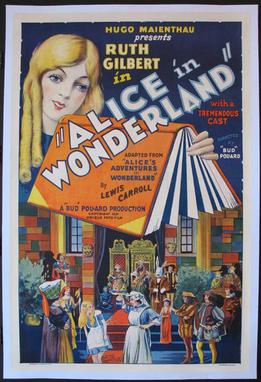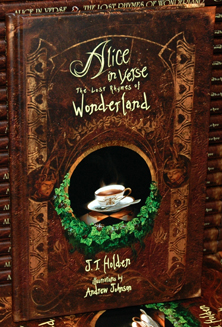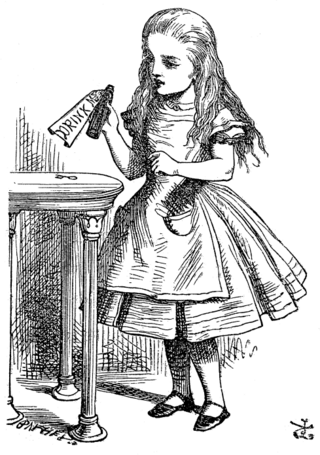
The Hatter is a fictional character in Lewis Carroll's 1865 book Alice's Adventures in Wonderland and its 1871 sequel Through the Looking-Glass. He is very often referred to as the Mad Hatter, though this term was never used by Carroll. The phrase "mad as a hatter" pre-dates Carroll's works. The Hatter and the March Hare are referred to as "both mad" by the Cheshire Cat, in Alice's Adventures in Wonderland in the sixth chapter titled "Pig and Pepper".

American McGee's Alice is a 2000 third-person action-adventure video game developed by Rogue Entertainment under the direction of designer American McGee and published by Electronic Arts under the EA Games banner. The game was originally released for Windows and Mac OS. Although a planned PlayStation 2 port was cancelled, the game was later released digitally for the PlayStation 3 and Xbox 360, via downloadable content for its sequel.

The Queen of Hearts is a fictional character and the main antagonist in the 1865 book Alice's Adventures in Wonderland by Lewis Carroll. She is a childish, foul-tempered monarch whom Carroll himself describes as "a blind fury", and who is quick to give death sentences at even the slightest of offenses. One of her most famous lines is the oft-repeated "Off with his/her head!" / "Off with their heads!"

The White Rabbit is a fictional and anthropomorphic character in Lewis Carroll's 1865 book Alice's Adventures in Wonderland. He appears at the very beginning of the book, in chapter one, wearing a waistcoat, and muttering "Oh dear! Oh dear! I shall be too late!" Alice follows him down the rabbit hole into Wonderland. Alice encounters him again when he mistakes her for his housemaid Mary Ann and she becomes trapped in his house after growing too large. The Rabbit shows up again in the last few chapters, as a herald-like servant of the King and Queen of Hearts.

Alice in Wonderland is a 1951 American animated musical fantasy comedy film produced by Walt Disney Productions and based on the Alice books by Lewis Carroll. The thirteenth release of Disney's animated features, the film features the voices of Kathryn Beaumont, Ed Wynn, Richard Haydn, Sterling Holloway, Jerry Colonna, Verna Felton, J. Pat O'Malley, Bill Thompson, and Heather Angel. The film follows a young girl named Alice who falls down a rabbit hole to enter Wonderland, ruled by the Queen of Hearts. Along the way, she encounters an odd assortment, including the Mad Hatter and Cheshire Cat.

The Caterpillar is a fictional character appearing in Lewis Carroll's 1865 book Alice's Adventures in Wonderland.

Adventures in Wonderland is a 1992–1995 American live-action/puppet musical television series based on the novels Alice's Adventures in Wonderland (1865) and Through the Looking-Glass (1871) by Lewis Carroll as well as the 1951 animated film. In the series, Alice, is portrayed as a girl who can come and go from Wonderland simply by walking through her mirror.

Lewis Carroll's books Alice's Adventures in Wonderland (1865) and Through the Looking-Glass (1871) have been highly popular in their original forms, and have served as the basis for many subsequent works since they were published. They have been adapted directly into other media, their characters and situations have been appropriated into other works, and these elements have been referenced innumerable times as familiar elements of shared culture. Simple references to the two books are too numerous to list; this list of works based on Alice in Wonderland focuses on works based specifically and substantially on Carroll's two books about the character of Alice.

Frank Beddor is an American former world champion freestyle skier, film producer, actor, stuntman, and author. He worked as a producer on There's Something About Mary and Wicked, and wrote the book The Looking Glass Wars.

The Looking Glass Wars is a series of three novels by Frank Beddor, heavily inspired by Lewis Carroll's 1865 novel Alice's Adventures in Wonderland and its 1871 sequel Through the Looking-Glass. The premise is that the two books written by Lewis Carroll are a distortion of the "true story".

Fushigi no Kuni no Alice is an anime adaptation of the 1865 novel Alice's Adventures in Wonderland which ran on the TV Tokyo network and other local stations across Japan from October 10, 1983 to March 26, 1984. The series was a Japanese-German co-production between Nippon Animation, TV Tokyo and Apollo Films. The series consists of 52 episodes, however, only 26 made it to the US.

Seeing Redd is a 2007 novel written by Frank Beddor inspired by Lewis Carroll's 1865 novel Alice's Adventures in Wonderland and its 1871 sequel Through the Looking-Glass.

Wonderland, formerly called Wonderland: Alice's New Musical Adventure or Wonderland: A New Alice, is a musical play with a book by Jack Murphy and Gregory Boyd, lyrics by Murphy, and music by Frank Wildhorn. The story, a contemporary version of the novels Alice's Adventures in Wonderland (1865) and Through the Looking-Glass (1871) by Lewis Carroll, is set in New York City and focuses on writer Alice Cornwinkle and her 10-year-old daughter Chloe.

Alice is a 2009 television miniseries that was originally broadcast on Canadian cable television channel Showcase and an hour later on American cable television channel Syfy. The miniseries is a reimagining of the classic Lewis Carroll novels Alice's Adventures in Wonderland (1865) and Through the Looking-Glass (1871), taking place about 150 years later with science fiction and additional fantasy elements added. The miniseries, produced by Reunion Pictures is three hours long, split into two parts, which premiered on Sunday, December 6, 2009, and Monday, December 7, 2009, respectively. Writer and director Nick Willing previously directed a 1999 adaptation of the books that followed the story more closely; however, Alice is intended to be a modern interpretation, imagining how Wonderland might have evolved over the last 143 years. The mini-series was partially shot in the Kamloops, British Columbia, Canada area.

Alice in Wonderland (1931) is an independently made black-and-white Pre-Code American film based on Lewis Carroll's 1865 novel Alice's Adventures in Wonderland, directed by Bud Pollard, produced by Hugo Maienthau, and filmed at Metropolitan Studios in Fort Lee, New Jersey.

Alice in Verse: The Lost Rhymes of Wonderland (2010) is a reimagining of Lewis Carroll's 1865 novel Alice's Adventures in Wonderland written by British-American author J.T. Holden. It tells the story of Alice's Adventures in Wonderland in 19 rhyming poems, each written in the same style as Lewis Carroll's original verse. The book includes 36 illustrations by American artist Andrew Johnson.

Alice, the main protagonist of Lewis Carroll's novels Alice's Adventures in Wonderland (1865) and Through the Looking-Glass (1871), has been adapted to several media.

Alice Through the Looking Glass is a 2016 American live-action/animated fantasy adventure film directed by James Bobin, written by Linda Woolverton and produced by Tim Burton, Joe Roth, Suzanne Todd, and Jennifer Todd. It is based on the characters created by Lewis Carroll and is the sequel to the 2010 film Alice in Wonderland. Johnny Depp, Anne Hathaway, Helena Bonham Carter, Matt Lucas, Mia Wasikowska, Alan Rickman, Stephen Fry, Michael Sheen, Barbara Windsor, Timothy Spall, Paul Whitehouse, Lindsay Duncan, Geraldine Page and Leo Bill reprise their roles from the previous film with Rhys Ifans and Sacha Baron Cohen joining the cast. It also features Rickman, Windsor and Andrew Sachs in their final film roles prior to their deaths. In the film, a now 22-year-old Alice comes across a magical looking glass that takes her back to Wonderland, where she finds that the Mad Hatter is acting madder than usual and wants to discover the truth about his family. Alice then travels through time, comes across friends and enemies at different points of their lives, and embarks on a race to save the Hatter before time runs out.

Alice in Wonderland, or simply Alice, is a Disney media franchise, commencing in 1951 with the theatrical release of the animated film Alice in Wonderland. The film is an adaptation of the books by Lewis Carroll, the 1865 novel Alice's Adventures in Wonderland and its 1871 sequel Through the Looking-Glass, which featured his character Alice. A live-action film directed by Tim Burton was released in 2010.


















